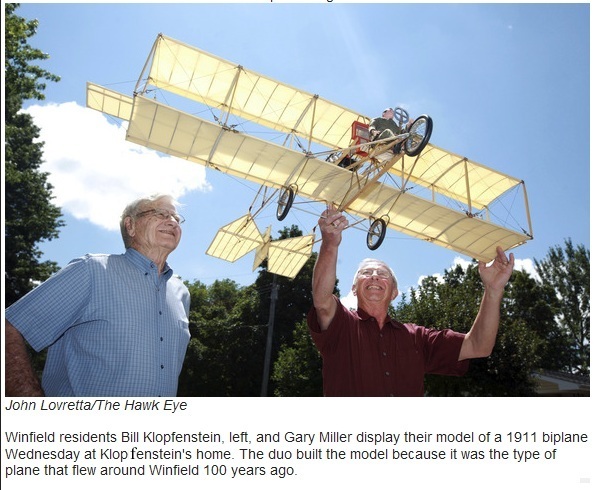

Winfield flight honored
Biplane model added to museum as tribute to 1911 fair attraction.
By JEFF HUNT
jhunt@thehawkeye.com
WINFIELD - Visitors to the Winfield Historical Society and Museum, 114 S. Locust St., won't be able to miss the latest addition to the exhibits. In the front window, suspended for all to see is a model of a 1911 Curtiss Pusher biplane.The plane, one-sixth the size of the original, was 100 years in the making.
Winfield resident Bill Klopfenstein decided to take on the venture after reading about a Curtiss Pusher plane visiting Winfield during the fair in 1911.
"This year's theme of Crooked Creek Days is 'Remembering the Fair,' " Klopfenstein said. "It was in 1911 that the fair board hired a pilot to fly the Curtiss Pusher biplane over the fairgrounds. That will be 100 years ago next month."
Klopfenstein enlisted the help of Gary Miller, who is a pilot but was hesitant to get involved at first.
"Klopfenstein asked me if he got the kit would I help him," Miller said. "I told him he really should have started it in October or November."
Miller said he would do what he could but had no idea what he was doing.
Between the two men and with some help of their wives, the plane was completed in seven weeks, with plenty of time to serve as a tribute to the Winfield flight a century ago.
Klopfenstein noted the idea to have a plane at the Winfield Fair came eight years after the Wright Brothers developed their "flying machines."
Fair organizers hoped the plane would draw bigger crowds, and Klopfenstein said it worked.
Around the turn of the 20th century the Winfield Fair was in its hay day, drawing participants from several states. But on the day the biplane was scheduled to fly, special arrangements were made to get more people to the fairgrounds. Trains came in from Burlington with stops in Sperry, Mediapolis and other towns so people could get a glimpse at the plane.
The population of Winfield was no more than 400 people in 1911, but plane flew over 5,000 people in the audience at the fair.
Carol, Klopfenstein's wife, said Winfield residents took a risk bringing the plane to town.
"The people in the city put up $1,000 to get the plane to town," she said.
The admission to the fair was doubled from 25 cents to 50 cents for the day the plane flew.
"You can do the math and see the city got its money back and then some," Carol Klopfenstein said.
Weather became an issue for the flight in Winfield.
"The day the plane was scheduled to fly, there was a storm so it never got off the ground," Bill Klopfenstein said. "They put it off until the next day."
Bill Klopfenstein said even then the winds were so strong some feared the plane would not be able to fly.
"The winds died down around 5 p.m., and the plane took off," Klopfenstein said.
Jean, Miller's wife, explained how the plane took off and landed.
"On the back side of the golf course is the old race track the horses used during the fair," she said. "The plane took off and landed there."
The plane was flown by Hugh Robinson, who later would become the first pilot to fly a complete loop.
The full-size Curtiss Pusher was equipped with an eight-cylinder engine. It was more than 30 feet long and weighed 700 pounds empty.
The model Klopfenstein and Miller built is five and a half feet long and can be carried by one person. It has three spoke rims, with each spoke attached to the rim.
Just like the actual plane, the model has a fender over the front tire, which allowed the pilot to step on it to slow the plane during landing. If the plane was still going to fast, a hook on the back of the plane could be deployed.
Not everything went as planned during construction of the model. Miller said trying to figure out how to attach the spokes became confusing. A gentleman at the town lumber yard designed a wooden tool to make the process easier.
The tires to go on the rims also were the wrong size, so a trip to the repair shop was required to find something to work better.
On the original plane steel cables in the wings were used to steer the plane. On the model, piano wire was used.
The Winfield fairs ended 25 years after the biplane flew over the town in 1911. Klopfenstein said the fairs were largely agriculture-based, and following a major drought in 1935 there were no more fairs.
Klopfenstein and Miller are considering putting the biplane in the Crooked Creek Days Parade on Saturday. Due to the design of the plane and the materials used, that decision will be based on the weather this weekend.